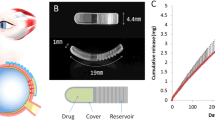Abstract
• Background: The highly swelling poly(glycerol monomethacrylate) gel (polyGLYMA) and hydrophilic polymer poly(triethylenglycol monomethacrylate (polyTEGMA) were tested as potential viscoelastics for intraopertive use in anterior segment surgery. • Methods: PolyGLYMA was implanted into the anterior chamber in 5 rabbits, and 40% polyTEGMA in 16 rabbits. The eyes were enucleated 1 week to 3 months after the operation. The corneal endothelium was examined with specular microscopy, and then the whole eye histopathologically. • Results: In all eyes of the polyGLYMA group, the clinical findings were characterized by a marked ciliary injection and severe secondary glaucoma, and the histologic ones by a marked inflammatory infiltration and thickening of Descemet's membrane in the anterior chamber angle. Specular microscopy revealed a decrease in the endothelial cell density and polymorphism of the endothelial cells. In the polyTEGMA group, the anterior segment and the fundus were physiologic all the time, and specular microscopy and histologic findings showed no degenerative and/or inflammatory changes. • Conclusions: PolyGLYMA proved unsuitable for intracameral application in rabbits. The new polymer polyTEGMA is characterized by high biologic tolerance after its implantation into the anterior chamber of rabbits. PolyTEGMA 40% might be considered as a potential viscoelastic material in humans.
Similar content being viewed by others
References
Alpar JJ, Fechner PU (1986) Viscoelastic and other materials for cushioning the anterior chamber and coating the intraocular lens. In: Fechner's intraocular lenses. Thieme, Stuttgart, pp 118–129
Daniele S, Refojo MF, Schepens CL, Freeman HM (1968) Glycerol Methacrylate Hydrogel as a vitreous implant. An experimental study. Arch Ophthalmol 80:120–127
Drago F, Neüschuler R, Cavaliere S, Spampinato D (1989) Physicochemical and pharmacological characteristics of hyaluronic acid. In: Michels RG, Stark WJ, Stirpe M (eds) Sodium hyaluronate in anterior and posterior segment surgery. Fidia, Padua, pp 1–18
Dvořák J, Kubát Z, Wichterle O, Štol M, Nejedly K (1982) Synthetic substitutes of the vitreous. Ceskoslov Oftalmol 38: 27–32
Menapace R, Skorpik Ch, Wedrich A (1989) Evaluation of 150 consecutive cases of poly HEMA posterior chamber lenses implanted in the bag using small-incision technique. J Cataract Refract Surg 16:567–577
Müller-Jensen K (1974) Alloplastic vitreous replacement with acrylamide. Mod Probl Ophthalmol 12:385–389
Pitrová Š, Smetana K, Wichterle O, Vacík J, Korynta J, Cendelín J (1992) First stage of clinical trials of hydrogel lenses made in Czechoslovakia. Ceskoslov Oftalmol 48:241–246
Refojo MF (1971) Polymers in ophthalmic surgery. J Biomed Mater Res 5:113–119
Author information
Authors and Affiliations
Rights and permissions
About this article
Cite this article
Karel, I., Kalvodová, B., Filipec, M. et al. Poly (triethylenglycol monomethacrylate) and poly(glycerol monomethacrylate) cross-linked gel as potential viscoelastics for intraoperative use. Graefe's Arch Clin Exp Ophthalmol 235, 186–189 (1997). https://doi.org/10.1007/BF00941727
Received:
Revised:
Accepted:
Issue Date:
DOI: https://doi.org/10.1007/BF00941727




